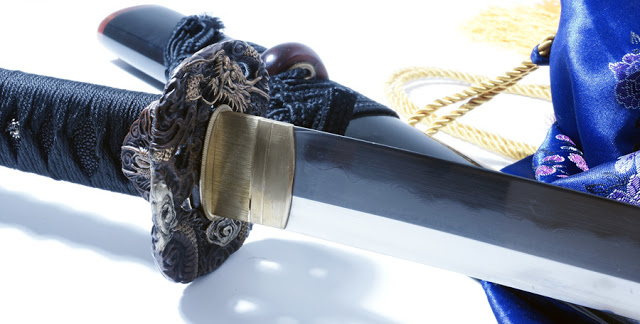The symbolism of the sword throughout history is profound.
It represents power and the ability to preserve life by taking life, to cut through to the core of truth, i.e., to discriminate between reality and nonsense and stand up for what is right.
The traditional Samurai sword, or Katana, has generally remained at the pinnacle of sword technology for many reasons: balance, shape, cutting power, etc. But it’s the making of the sword that is the most interesting as it has so many lessons for life.
Iron ore and a small amount of charcoal are smelted together in a furnace to produce steel. The sword maker pounds that into a long flat bar which he then rolls over on itself, heats it again, pounds and rolls it again. This heating, pounding and rolling process is repeated over and over, until a unique shape and quality is achieved.
The process must be masterful. It is achieved by a highly skilled and experienced artisan, who learned by being apprenticed to a master craftsman. If the steel is heated too much, the sword becomes too hard and not resilient, so not only is the blade difficult to sharpen, but sooner or later the steel will break in two.
And if not heated enough it becomes brittle and cracks at the slightest impact, easy to sharpen, but of no practical use. Only after that process is complete can clay then be applied along one edge. The nearly-sword is gently heated a final time before being plunged into ice-cold water, forcing the steel to curve more on one side than the other, giving it that unique “samurai sword” look.
Some time is then spent on adding the hilt and decorative aspects which relate specifically to the new owner. And finally the sword is sharpened to the highest degree possible, where it can unhesitatingly make the difference between saving the owner’s life…or taking it. It is a priceless, unique and totally effective instrument.
As human beings, we too are made from two different “elements,” an ovum and a microscopic sperm cell, smelted together in the furnace of our mother’s womb. The birth process is our first “pounding” and we arrive into the world a different shape than when we were in the womb. Life then continues to heat, roll and pound us until a unique identity and attitudinal shape is formed.
This process, mostly performed by our parents, is crucial and best performed by highly skilled and experienced artisans, who have themselves been mentored by their masters (grandparents). Too much heat in the form of inappropriate expectations, conflict, frustration, anger and conditional love, can lead to hardness without flexibility and resilience. Then the intellect is difficult to sharpen and eventually ‘the last straw’ will cause a breakdown of emotional control. And so damage will result, usually externally in the form of rage, lost jobs and hurt relationships.
Conversely, not enough heat, for example in the form of lack of conflict management, lack of discipline and focus and affection instead of love, can lead to a brittle emotional state and low self-esteem, where the intellect can be easily sharpened but is essentially dysfunctional due to the lack of emotional mastery.
Life by its very nature also pounds and rolls us in the form of hardships and challenges which we must accommodate and bounce back from in order to live a successful, fulfilling life; relationships, finances, family, funerals, occupation and the plain unexpected are the sword maker’s anvil on which our attitudes, thoughts and feelings are shaped and formed.
There are several crucial periods in our life where this pounding takes on a special significance, where we transition from one period or phase of life into the other. Two years old, seven,14 and 21 are those traditional times, where the elders of the tribe would guide us through a particularly rigorous initiation to prepare us for what lies ahead.
The final and perhaps most important phase occurs usually in our mid-40s to 50s, when we retain the clay of personal integrity as we are plunged into the freezing waters of self-reflection to reassess our values, priorities and unfulfilled dreams. We change our perspective on life, become slightly “bent” and nothing is quite so black and white anymore.
This bending must be precise, as once bent, you can never see life the same way again and it affects the balance and functionality of the sword from then on. It is the period that holds the most potential for enlightened spiritual awakening.
That is how a sword is made. The art is to not take the ‘”making” personally, it’s simply the sacred sword maker doing his job—with perfection as his goal. When we remain open and alert to the precious lessons life has for us, we can allow and welcome the heating, pounding, shaping and sharpening as the most powerful, unconditional and sacred gift that it actually is.
Love elephant and want to go steady?
Sign up for our (curated) daily and weekly newsletters!
Apprentice Editor: Edith Lazenby/Editor: Travis May
Photo: Rino bukan Badhak/Pixoto











Read 13 comments and reply